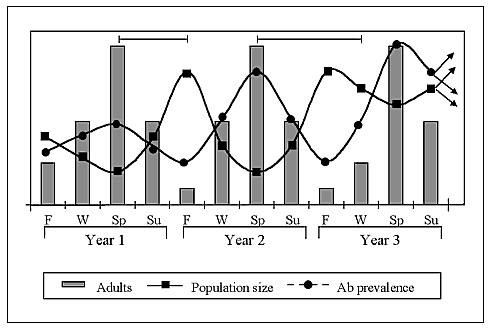Volume 5, Number 1—February 1999
Research
Long-Term Studies of Hantavirus Reservoir Populations in the Southwestern United States: A Synthesis
Figure

Figure. A hypothetical schematic of seasonal changes in hantavirus prevalence, rodent host population density, and population age structure.In the first autumn, after a normal breeding season, the high density population consists primarily of young not exposed to virus or recently exposed before development of antibody. Because of deaths in winter, populations decrease to a spring nadir. However, antibody prevalence is high in this population of overwintered adults exposed during the previous breeding season or during winter communal huddling. Unusually favorable conditions during the following spring and summer (first horizontal bar) result in higher population density the second fall, and the increased influx of young of the year (juvenile dilution effect) results in an even lower antibody prevalence than the previous fall. A typical winter results in a high number of winter deaths and a typical low density spring population, but seroprevalence the second spring is higher because of increased opportunities for transmission events in the high density population of the previous fall. The second extended favorable season (second horizontal bar) leads again to high population density and low seroprevalence in autumn. The reservoir population of the third spring demonstrates high antibody prevalence, because of high rates of exposure during the "crowded" conditions of the previous fall, and unusually high population density, because of extended breeding and high overwinter survival. Depending on environmental conditions, the population may abruptly "crash" (if it has exceeded the carrying capacity of the environment) or might continue to increase (e.g., if growing conditions the previous spring and summer resulted in abundant food supplies, such as a mast crop of acorns or pinyon nuts).